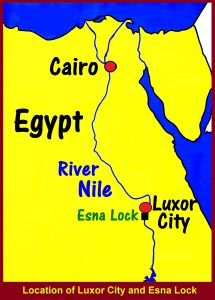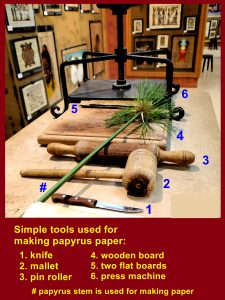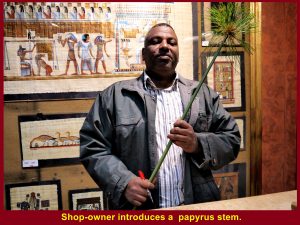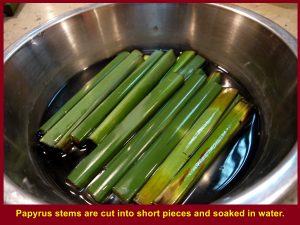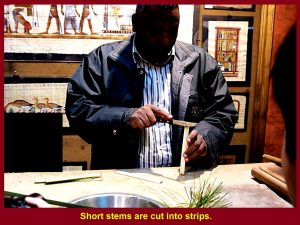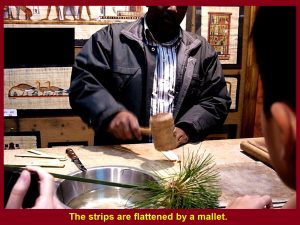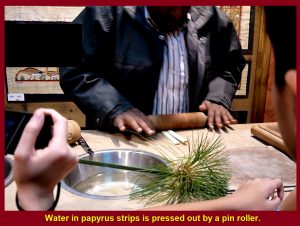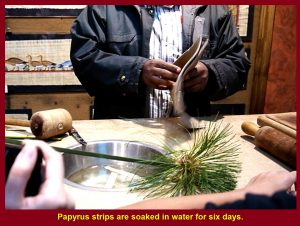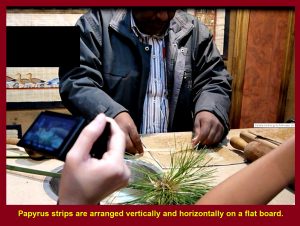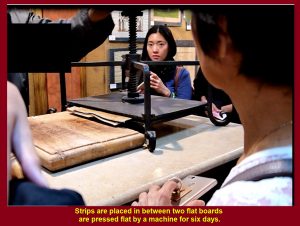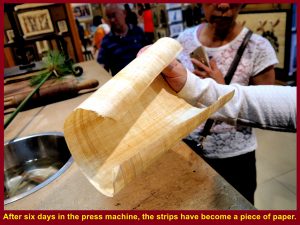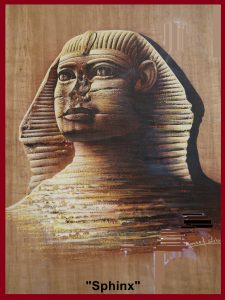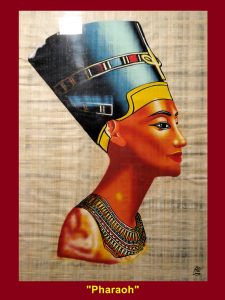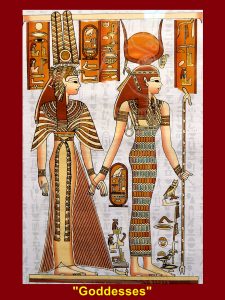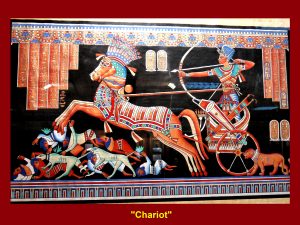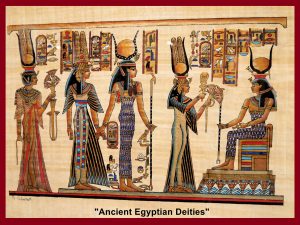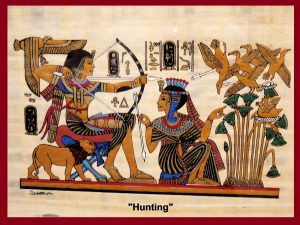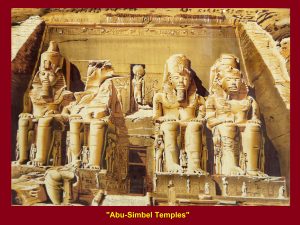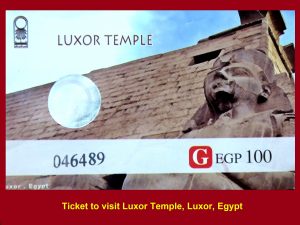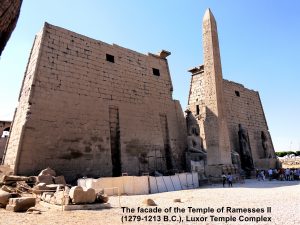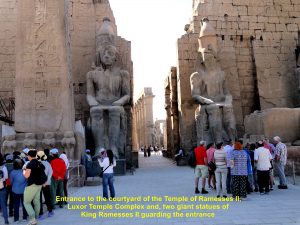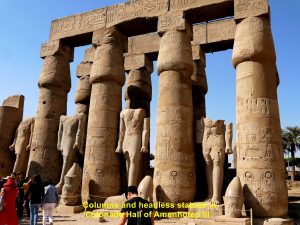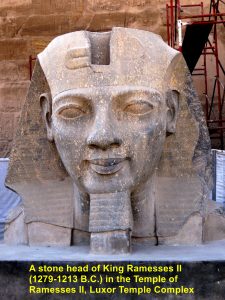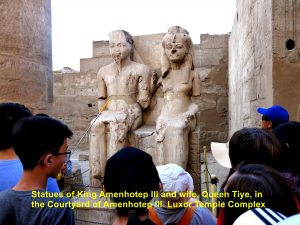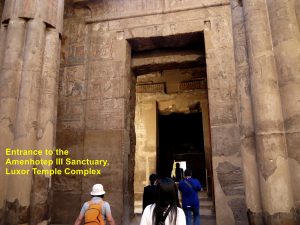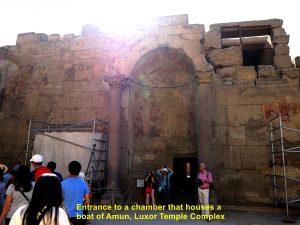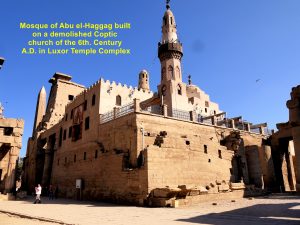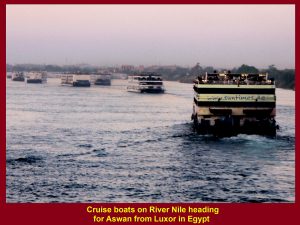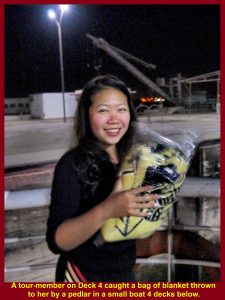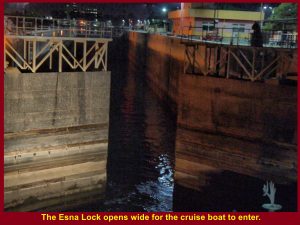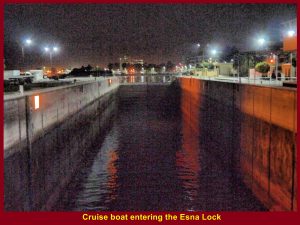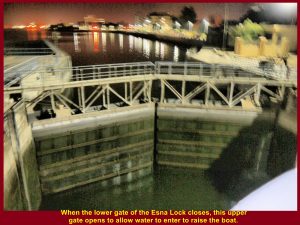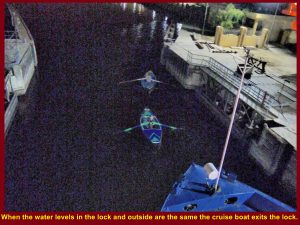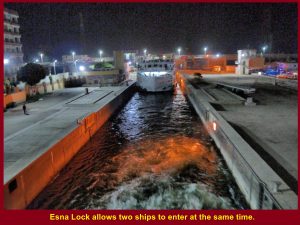Egypt Travel IV: Papyrus Paper Making, Luxor Temple Complex and Esna Lock
Egypt Travel IV: Papyrus Paper Making, Luxor Temple Complex and Esna Lock
Papyrus Paper-Making Lesson at Sondos Papyrus Shop in Luxor
After seeing the Karnak Temple Complex we visited a shop in Luxor City that was selling paintings on papyrus papers. It was called Sondos Papyrus.
When we entered the shop we were given a lesson on papyrus paper making by the owner. He showed us the method of doing it using simple tools as shown in the photos below.
Simple Tools for Papyrus Paper-Making
First he showed us papyrus stems.
The stems were cut into short pieces and soaked in a bowl of a dark liquid.
Then he cut the stems into thin strips.
The strips were flattened by a mallet.
He used a pin-roller to squeeze out the water in the flattened strips.
Next, he said that the strips had to be soaked in water for six days to make them soft.
Arrangement of Papyrus Strips
He took out some papyrus strips that had already soaked for six days and arranged them vertically and horizontally on a flat sheet of rubber until they looked like a piece of paper.
Pressing Machine
He put the arranged strips in a machine and pressed out the water. He said that they would be left inside for six days when they would become a piece of paper.
Papyrus Paper
The gentleman took out a readily made papyrus paper and said that the strips would look like that piece of paper after six days
Writing and Painting
The papyrus paper can be used for writing and painting. It was used by ancient Egyptian rulers.
Below are some of the paintings drawn on papyrus papers which were displayed in the shop and for sale.
“Sphinx”
“Pharaoh”
“Tree of Life”
“Goddesses”
“Chariot”
“Ancient Egyptian Deities”
“Hunting”
“Abu-Simbel Temples”
Visiting Luxor Temple Complex
Having spent an hour at Sondos Papyrus shop, we went to a historical site near Luxor City and it is known as Luxor Temple Complex.
Luxor Temple Complex
Luxor Temple Complex was built by two kings, Ramessess II(1290-1224 B.C.) and Amenhotep III(1391-1353 B.C.). Later, the Roman Emperor, Diocletlan(244-312 A.D.), built a fortress round it in the late 3rd. Century A.D.. Then churches were built at the Luxor Temple Complex.
Ticket to enter the Luxor Temple Complex
Temple of Ramesses II
The Temple of Ramesses II was one of the temple we visited at the Luxor Temple Complex.
Below are some photos showing parts of the Temple of Ramesses II
Facade or Pylon of the Temple of Ramesses II(1279-1213 B.C.)
Entrance to the Temple of Ramesses II flanked by the statues of Ramesses II at the Lixor Temple Complex
Obelisk of King Ramesses II(1279-1213)
There were actually two obelisks of King Ramesses II at the temple entrance. But only one is left and the other is kept in Paris, France.
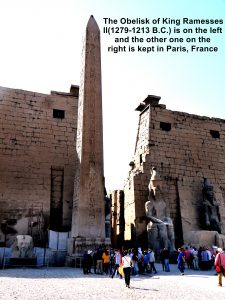
The Obelisk of Ramesses II on the left and the missing one on the right(now in Paris, France) at the entrance of the Temple of Ramesses II
Courtyard in the foreground and Tripartite Shrine in the background of the Temple of Ramesses II
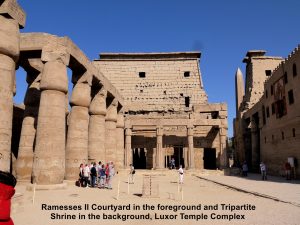
Courtyard of Ramesses II in the foreground and the Tripartite Shrine in the background in the Temple of Ramesses II
Colonnade Hall of Amenhotep III(Reign:1391-1353 B.C.) and Tutankhamun(Reign:1332-1323 B.C.)
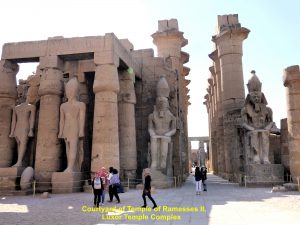
Courtyard of Ramesses II in the foreground and Colonnade Hall of Amenhotep III and Tutankhamun in the background
Columns and Statues in the Courtyard of Amenhotep III, LuxorTemple Complex
Stone Head of Ramesses II in the Temple of Ramesses II, Luxor Temple Complex
Statues of King Amenhotep and his wife, Tiye
Entrance to the Amenhotep III Sanctuary
Amun’s or Sun God’s Boat
Mosque of Abu el-Haggag
There is a mosque in the compound of Ramesses II Temple at the Luxor Temple Complex. Known as Abu el-Haggag, it was built on a ruined Coptic church of the 6th. Century A.D..
50000 Stone Blocks
There are over 500 000 stone blocks outside the temple of Ramesses II which are from the walls of the ruined Temple of Ramesses II and other temples too.
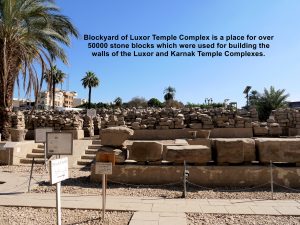
Blockyard of Luxor Temple Complex has a collection of over 50000 stones that are from the walls of the ruined temples at the Luxor Temple Complex
Sailing to Edfu
In the evening we left Luxor City and went back to our cruise boat on River Nile. Soon our boat set sail for Edfu which is 60 km south of Luxor.
River Nile Pedlars
On the way, we saw some pedlars on their small boats tied to our moving large boat trying to sell their textile products to the passengers.
I was fascinated by the way those pedlars doing their sales.
Pedlar’s Sale-Method
A pedlar will call passengers on a cruise boat, loudly. If he spots one looking down at him, he will strike a friendly conversation with him/her and then show his product. Before the passenger can give him a positive or negative answer, the latter throws his product in a waterproof plastic bag to him/her with accuracy. He will ask the person to have a look at the product, put the money in the same bag and throw it back to him if the price is acceptable to the passenger. Otherwise, he has to throw the product back to the pedlar.
Cruise boats sailing on River Nile from Luxor to Aswan
Esna Lock
To go to Edfu from Luxor our cruise boat had go through a lock at Esna in order to get to the higher water level of River Nile.
Esna Lock Pedlars
At the Esna Lock, pedlars in small boats tried to sell their goods to us. We were amazed that they could throw their goods to us while we were on the top deck of our boat which was about 13 metres above the water level!
Two Pedlars in Esna Lock with their goods
A tour-member caught a pedlar’s product but she threw it back to him as she did not need it.
Lower and Upper Gates of Locks
The Esna Lock allows two cruise boats to enter at a time. The photos below show the working of the lock.
Opening of Lower Gate
The lower gate opens, slowly, and the water flows out.
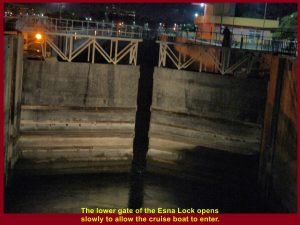
The lower gate of the Esna Lock opens slowly to allow the cruise boat to enter.
Lower Gate Opening Wide
When the lower gate is wide, the boat enters the lock.
Cruise Boat entering the Esna Lock
The boat enters the lock, slowly.
Opening of Upper Gate
When the boat is inside the lock, the lower gate closes. Then the upper gate opens to allow water to flow into the lock raising the boat.
Boat Exiting Lock
When the water level inside the lock is the same as the outside, the boat sails out of the lock and continues its journey to the south.
Two boats are allowed to enter the lock at a time
40 Minutes in the Lock
A cruise boat will take about 40 minutes to pass through the Esna Lock.
After passing through the lock, our boat continued the journey to Edfu in the south.
Before dawn broke, we reached Edfu.
(Continue in Egypt Travel Part V)
Egypt Travel Parts I to XII
Egypt Travel Part I :Salah el Din Citadel, Muhammad Ali Mosque, Tahrir Square and Egyptian Museum
Egypt Travel Part II :Valley of the Kings, Hatshepsut Temple and Colossi of Memnon
Egypt Travel Part III :Hot Air Balloons and Karnak Temple Complex
Egypt Travel Part IV :Papyrus Paper-Making, Luxor Temple and Esna Lock
Egypt Travel Part V :Edfu Temple, Kom Ombo Temple and Galabia Party
Egypt Travel Part VI :Abu Simbel Temples and Nubian Village(Elephantine Island)
Egypt Travel Part VII :Unfinished Obelisk, Aswan High Dam and Philae Temple
Egypt Travel Part VIII:Ahmed Hamdi Tunnel, Moon Beach(Ras Sudr), and St. Catherine
Egypt Travel Part IX :Mount Sinai, Catherine’s Monastery and Sharm el Sheikh
Egypt Travel Part X :Sharm el Sheikh
Egypt Travel Part XI :Cairo Food, Saqqara Step Pyramid Complex and Memphis
Egypt Travel Part XII :Great Giza Pyramid Complex and Khan el Khalil Bazaar
Comments
Tell me what you're thinking...
and oh, if you want a pic to show with your comment, go get a gravatar!

